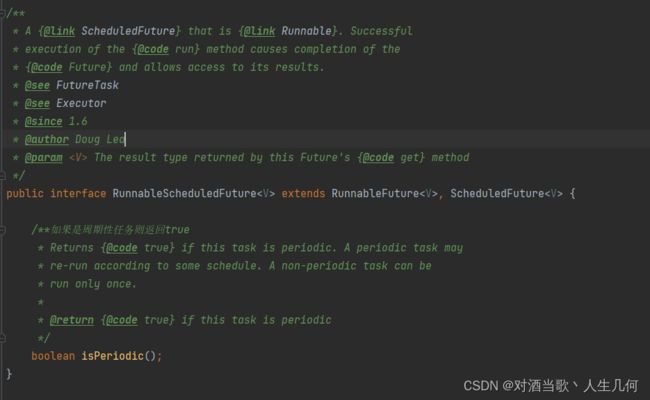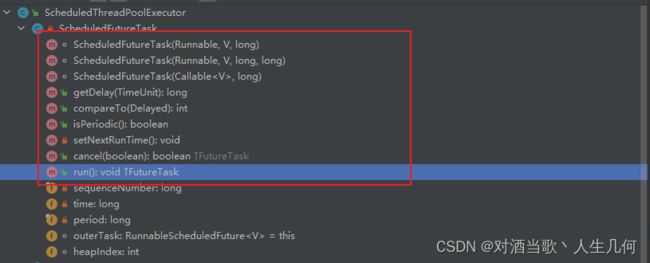深度解析ScheduledThreadPoolExecutor源码之ScheduledFutureTask
文章目录
- 引言
- 一、RunnableScheduledFuture定义周期性接口
- 二、ScheduledFutureTask源码分析
-
- 2.1 ScheduledFutureTask参数解析
- 2.2 ScheduledFutureTask源码方法解析
- 总结
引言
在上一章节我们已经对ScheduledThreadPoolExecutor中的延迟队列DelayedWorkQueue做了源码分析深度解析ScheduledThreadPoolExecutor源码之DelayedWorkQueue,接下来我们将对ScheduledThreadPoolExecutor中的另一个核心类ScheduledFutureTask做源码讲解。在阅读此文章之前,希望您已经掌握了关于JDK中关于Future和FutureTask相关的知识点,如果您对FutureTask的原理还不太了解,您可以先阅读文章Java中的Future源码讲解进行初步了解。
一、RunnableScheduledFuture定义周期性接口
ScheduledFutureTask继承FutureTask标志着该类可以作为Runnable接口的实现类放入Thread线程中运行,关于FutureTask的源码解析可参考文章Future源码讲解,在此处就不再过多解析。ScheduledFutureTask除了继承FutureTask之外,还实现了接口
RunnableScheduledFuture,因为仅仅继承FutureTask类只能保证ScheduledFutureTask可以放在Thread中运行,但是并无法标识该任务是一次性任务还是周期性任务还是延迟任务。因此RunnableScheduledFuture接口提供了方法isPeriodic来让其实现类标识是否是周期性任务。

因此ScheduledFutureTask只需要实现RunnableScheduledFuture接口中的isPeriodic方法,通过返回的布尔值即可标识当前任务是否是周期性任务。现在解决了标识一个任务是否是周期性任务的问题,另一个问题则是如何计算任务应该何时运行,ScheduledFuture被RunnableScheduledFuture所继承,在ScheduledFuture又继承了Delayed接口,Delayed接口定义了一个方法getDelay用于返回待延迟执行的时间戳值。规定如果getDelay返回的值大于0,则表示该任务还未到执行时间,如果等于或者小于0,则表示当前任务可以被执行。
/**
* A delayed result-bearing action that can be cancelled.
* Usually a scheduled future is the result of scheduling
* a task with a {@link ScheduledExecutorService}.
*
* @since 1.5
* @author Doug Lea
* @param The result type returned by this Future
*/
public interface ScheduledFuture<V> extends Delayed, Future<V> {
}
请注意看,Delayed 继承了Comparable接口,因此实现该接口的类,可以通过实现Comparable提供的compareTo方法进行比较,根据两个任务调用getDelay方法返回值来判断哪个任务优先执行,结合DelayedWorkQueue的最小堆算法,则可以保证任务执行的顺序
public interface Delayed extends Comparable<Delayed> {
/**
* Returns the remaining delay associated with this object, in the
* given time unit.
*
* @param unit the time unit
* @return the remaining delay; zero or negative values indicate
* that the delay has already elapsed
* 返回还剩多长时间任务才能被允许执行
* 如果返回0或者负数,表示任务已经过期,应该马上被执行
* 实现该接口的元素,会根据延迟时间的顺序被放入队列(PriorityQueue),时间越短则越靠近对头
*/
long getDelay(TimeUnit unit);
}
public interface Comparable<T> {
public int compareTo(T o);
}
至此,对ScheduledFutureTask大体的实现流程有一定的概念,即:ScheduledFutureTask继承FutureTask以至于可以作为Runnable接口实现类放入Thread中运行,实现接口RunnableScheduledFuture的isPeriodic方法可以确定任务的类型(定时周期性、延迟周期性、一次性任务),实现接口Delayed的getDelay方法,计算出任务可执行的时间,接着通过实现Comparable提供的compareTo方法,将两个任务通过getDelay方法返回的值进行比较,getDelay返回的数值越小,则任务越应该尽早的执行,有了比较的依据,则通过最小堆算法放入DelayedWorkQueue中,等待线程获取任务执行。以上就是ScheduledFutureTask实现的大体流程,接下来我们将结合代码进一步仔细分析。
二、ScheduledFutureTask源码分析
ScheduledFutureTask作为FutureTask的增强类,增加了getDelay方法用于计算任务当前时间是否应该被执行,compareTo方法则用于比较多个任务之间执行顺序排序。isPeriodic方法则可以标识当前任务是否是周期性任务。接下来我们进入JDK源码从上往下依次解析每个参数与方法的具体作用和实现。

2.1 ScheduledFutureTask参数解析
ScheduledFutureTask中定义的参数比较少,sequenceNumber是相当于一个任务的身份标识,当创建一个任务(ScheduledFutureTask)时会为任务的属性sequenceNumber赋值一个唯一值用于区分任务。time参数用于记录任务何时应该执行的时间戳。period则是用于标识一个任务的类型(周期性、延迟任务、单次任务)。outerTask则是记录任务本身,如果任务是周期性的时候,执行完一次任务后可以将该任务重新放入DelayedWorkQueue中。heapIndex则是记录当前任务在二叉堆中的索引位置,记录该位置是为了更方便通过索引查到任务。关于二叉堆的相关知识点,我们已经在上一章节讲过,请参考文章深度解析ScheduledThreadPoolExecutor源码之DelayedWorkQueue
/**
* Sequence number to break ties FIFO 分配的唯一序列号
*/
private final long sequenceNumber;
/**
* The time the task is enabled to execute in nanoTime units
* 执行任务的时间
*/
private long time;
/**
* Period in nanoseconds for repeating tasks. A positive
* value indicates fixed-rate execution. A negative value
* indicates fixed-delay execution. A value of 0 indicates a
* non-repeating task.
* 一个积极的取值表示固定速率执行。
* 负值固定延迟执行。
* 0表示无重复的任务
* 重复任务的周期,以纳秒为单位 表示是否周期性任务,还是延迟任务
*/
private final long period;
/**
* The actual task to be re-enqueued by reExecutePeriodic
* ScheduledFutureTask对象,实际指向当前对象本身
*/
RunnableScheduledFuture<V> outerTask = this;
/**
* Index into delay queue, to support faster cancellation.
* 当前任务在延迟队列中的索引
*/
int heapIndex;
2.2 ScheduledFutureTask源码方法解析
ScheduledFutureTask中方法并不多,根据这些方法的名称大概能猜测每个方法的作用,接下来我们将通过源码对每个方法进行解析。

ScheduledFutureTask 提供了三个构造方法,super(r, result)则是调用父类FutureTask将传入的Runnable和result构建成一个Callable并初始化任务状态为NEW。如果您对FutureTask的实现还不太清除,您可以参考文章 Future源码讲解。将传入的执行时间戳赋值给time,因为time用于记录任务何时执行,period 则是标识该任务是否为周期性任务,如果不传则默认为0,表示当前任务是周期性任务。第三个构造函数允许您传入自己定义的callable,这样就不再由FutureTask自动为你构建callable。
/**
* Creates a one-shot action with given nanoTime-based trigger time.
* 传入Runnable和一个固定的返回值,并指定任务执行的时间
*/
ScheduledFutureTask(Runnable r, V result, long ns) {
super(r, result);
this.time = ns;
this.period = 0;//表示是一个单次任务
this.sequenceNumber = sequencer.getAndIncrement( );
}
/**
* Creates a periodic action with given nano time and period.
* 创建具有给定纳米时间和周期的周期性动作。
*/
ScheduledFutureTask(Runnable r, V result, long ns, long period) {
super(r, result);
this.time = ns;
this.period = period;
this.sequenceNumber = sequencer.getAndIncrement();
}
/**
* Creates a one-shot action with given nanoTime-based trigger time.
* 使用给定的基于nanotime的触发时间创建一个一次性动作。
*/
ScheduledFutureTask(Callable<V> callable, long ns) {
super(callable);
this.time = ns;
this.period = 0;
this.sequenceNumber = sequencer.getAndIncrement();
}
getDelay方法来源于Delayed接口,getDelay方法返回值用于确定任务是否到了可执行状态,如果返回值大于0,则表示任务还需要等待返回值的时间才能执行,如果小于等于0,则表示任务可以被执行。time在参数讲解的时候提到过,time记录着该任务可被执行的时间,time - now() 则返回可执行时间于当前时间的差值,从而判断任务是否到了可执行时间。
/**
* 获取当前任务延迟执行的时间
*
* @param unit
* @return
*/
public long getDelay(TimeUnit unit) {
return unit.convert(time - now(), NANOSECONDS);//time记录着任务应该被执行的时间,time-now()==等于距离可执行时间的差值
}
isPeriodic方法来源于接口RunnableScheduledFuture,用于定义一个任务的类型(周期性、一次性),通过参数period 是否为0来确定是否为周期性任务。在进行ScheduledFutureTask构建时,可由用户自己定义任务类型。
/**
* Returns {@code true} if this is a periodic (not a one-shot) action.
*如果这是一个周期性的(不是一次性的)动作,返回{@code true}。
* @return {@code true} if periodic
*/
public boolean isPeriodic() {
return period != 0;
}
setNextRunTime方法用于计算出任务下一次执行时间,如果period为0,则表示任务为周期性,则可以计算出下一次执行时间并赋值给time参数,如果为负数,则表示任务是延迟任务,只需要调用triggerTime方法计算出延迟后任务的执行时间即可。
/**
* Sets the next time to run for a periodic task.
* 为周期性任务设置下一次调度时间
*/
private void setNextRunTime() {
long p = period;
if (p > 0) { //如果p大于0,则表示当前任务是一个固定速率的任务,只需要在本次任务执行的时间+p则可以算出下次任务执行的时间
time += p;
}
else { //延迟动作的触发时间
time = triggerTime(-p);
}
}
cancel方法用于取消任务,调用父类FutureTask中的cancel方法将任务状态置为取消,并调用remove方法将该任务从DelayedWorkQueue中移除。
/**
* 设置是否可以在任务运行时进行任务取消
* @param mayInterruptIfRunning
* @return
*/
public boolean cancel(boolean mayInterruptIfRunning) {
boolean cancelled = super.cancel(mayInterruptIfRunning);
if (cancelled && removeOnCancel && heapIndex >= 0)
remove(this);
return cancelled;
}
compareTo方法来源于接口Comparable,用于比较两个任务的顺序,离执行时间越近的越先执行。如果任务类型是ScheduledFutureTask,则先通过参数time比较两个任务谁先执行,如果两个任务的执行时间一直,则比较sequenceNumber ,一般来说任务越先创建,sequenceNumber就越小。如果任务非ScheduledFutureTask类型,则通过getDelay方法比较谁离执行时间更近。
/**
* 任务比较,用于在插入和出列是进行排序
*
* @param other
* @return
*/
public int compareTo(Delayed other) {
if (other == this) // compare zero if same object
return 0;
if (other instanceof ScheduledFutureTask) {
ScheduledFutureTask<?> x = (ScheduledFutureTask<?>) other;
long diff = time - x.time;
if (diff < 0)
return -1;
else if (diff > 0)
return 1;
//此处的比较是,当前两个任务的执行时间一致时(time都一致),则根据sequenceNumber比较,sequenceNumber是在创建任务时设置的
// sequenceNumber越小,则任务越先创建
else if (sequenceNumber < x.sequenceNumber) {
return -1;
} else {
return 1;
}
}
long diff = getDelay(NANOSECONDS) - other.getDelay(NANOSECONDS);
return (diff < 0) ? -1 : (diff > 0) ? 1 : 0;
}
run方法来源于Rnnable接口,是任务执行的最核心代码。ScheduledFutureTask重写了FutureTask中的run方法,因此任务执行时,正在执行的代码就是这个方法。首先通过方法isPeriodic判断任务是否为周期性任务,然后通过canRunInCurrentRunState判断任务是否能被执行,如果当前状态无法被执行,则调用cancel方法取消任务。如果任务为非周期性任务,则直接调用父类ScheduledFutureTask.super.run允许任务,如果是周期性任务,则调用cheduledFutureTask.super.runAndReset(),方法runAndReset可以允许任务并在允许完成后将任务状态重置,以此来实现任务的周期重复调用。执行完成后计算出任务下一次执行时间,调用reExecutePeriodic方法尝试将任务重新放入DelayedWorkQueue中等待执行。任务放入DelayedWorkQueue就是调用DelayedWorkQueue的offer方法,这样ScheduledFutureTask与DelayedWorkQueue就关联起来。
/**
* Overrides FutureTask version so as to reset/requeue if periodic.
* 覆盖FutureTask版本,以便定期重置/重新请求。
* 任务允许的真正入口
*/
public void run() {
boolean periodic = isPeriodic();//是否是周期性任务
if (!canRunInCurrentRunState(periodic)) { //判断当前任务是否能被允许,查看线程池状态
cancel(false);//如果当前任务不能被允许,则尝试取消该任务,中断当前线程
}
else if (!periodic) {
ScheduledFutureTask.super.run(); //如果当前任务非周期性任务,则直接调用一次run方法后结束
}
else if (ScheduledFutureTask.super.runAndReset()) { //如果是周期性任务,则调用runAndReset方法运行任务,重置任务状态
setNextRunTime();//任务完成后计算该任务下一次运行时间
reExecutePeriodic(outerTask);//尝试将该任务重新放入延迟队列中等待下次继续运行
}
}
总结
通过本章节对ScheduledFutureTask的解析,再结合上文深度解析ScheduledThreadPoolExecutor源码之DelayedWorkQueue,我们已经将ScheduledThreadPoolExecutor中两个核心的类进行了全方位解析。剩余的内容则是对ScheduledThreadPoolExecutor内部参数与方法的解析。我们打算将这一部分放到第三章节去讲解。